The Frost Report
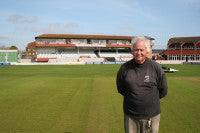 As this article was being compiled, Phil Frost, Head Groundsman at Somerset County Cricket Club, could be seen, on Sky TV, reversing his John Deere Gator off the outfield at a speed that most would not travel forward! Whilst his dexterity amused the commentators, especially as he manoeuvred through a narrow gap in the advertising hoardings, his urgency was to remove the covers on a rain affected third day of the LV County Championship match between Durham and Somerset so that play could begin.
As this article was being compiled, Phil Frost, Head Groundsman at Somerset County Cricket Club, could be seen, on Sky TV, reversing his John Deere Gator off the outfield at a speed that most would not travel forward! Whilst his dexterity amused the commentators, especially as he manoeuvred through a narrow gap in the advertising hoardings, his urgency was to remove the covers on a rain affected third day of the LV County Championship match between Durham and Somerset so that play could begin.
The wicket at Taunton is renowned for being 'batsman friendly' and, as if to prove the point, Durham amassed a huge 543 in their first innings. However, as if to completely poo poo that theory, the home side were skittled out for just 69 runs. In truth it was a combination of poor shot selection against a very strong Durham bowling attack that included Steve Harmison and Graham Onions, who celebrated his call up to the England Test squad with figures of 6-31.
The County Ground at Taunton is undergoing huge improvements with new stands being built around the ground. In keeping with many other clubs, these are being named after former and current players. The existing Ian Botham stand has had the prefix 'Sir' added, whilst the Andrew Caddick pavilion nears completion and the Marcus Trescothick Stand now hosts spectators.

The huge 'west' stand awaits the completion of sixty-four retirement apartments before officially being named, but ex-players of the stature of Viv Richards, Joel 'Big Bird' Garner', BBC TMS Commentator Vic Marks and current Director of Cricket, Brian Rose, must surely be in the running.
It was Brian Rose who led the county to their first successes in the late 1970s and early 80s - perhaps not difficult with Botham, Richards and Garner in the team. Rose has now adopted a strong youth policy, building a team around the experienced Justin Langer, Marcus Trescothick and Andy Caddick.
A young Phil Frost could well have been part of that successful 'Rose' team had circumstances not got in the way. He joined the club as a youth player in 1971 at the age of fifteen. "I was an all-rounder" he claims, "but became more and more involved with helping out on the ground, cutting the outfield and learning how to prepare wickets under the guidance of Don Price. But, at that young age, I didn't really want to become a groundsman and always planned to join the police force when I reached nineteen."
Since the club's formation in the late 19th century, they have only ever had six head groundsmen. The first was Harry Fearney who was replaced by Cecil Buttle in the 1930s. Then followed Don Price, Gordon Prosser, Len Smith and Phil. Sort of!
"When Don left in 1979, I was offered the job. I was only twenty-two and soon realised that, actually, I was not experienced enough to do the job, so stepped down. The club employed Gordon Prosser and I worked under him until 1983, when I left to work for the County Council, working on all their sports facilities. When Gordon left, Len Smith replaced him, but only stayed a year before moving to Sophia Gardens. The club then contacted me to see if I would come back as head groundsman. Twenty-two years later I'm still here."
In that time Phil has won Cricket Groundsman of the Year on five occasions and finished runner-up a further five times. "It always goes to that Bill Gordon at the Oval. Don't know how he does it?" he says with a grin on his face.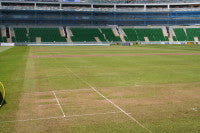
Phil's west country brogue belies a steely determination to keep improving. Underneath the flowing grey locks is a man always keen to do the best job he can. "But the level of cricket now being played here makes it more and more difficult" he says. One gets a sense that Phil is not overly happy with the edicts being bandied about by the authorities.
"Look" he says, "My job is to prepare the best wicket I can within the timescale available. I am being told that wickets should be a more even contest between bat and ball. Fair enough, but to try and do that I need time on my wickets. And how can I do that when the fixture list is so crammed? And it's not just the county games - LV, Friends Provident, Pro 40, Twenty20 - I've also got to accommodate One Day Internationals (ODI's), The Ladies Twenty20 World Cup as well as other ladies matches. I'm not moaning, just making an observation."
Even the pre-season schedule is heavy. "The head coach gave me the schedule of matches" said Phil ... and you just know, from the look on Phil's face, that there's an amusing story coming! "We've got Gloucester for a one day match, Glamorgan for two days and Derby for three" he proclaimed. "I looked at him and said, 'Do you want to ring round the other fifteen counties and invite them down as well'. He didn't get it at first but, about an hour and a half later my phone went. 'Frosty, you are a b**tard, I've just realised what you said!' I had to laugh."
And it doesn't stop there. "We had baseball matches and corporate events at the end of the cricket season. Obviously, I covered the square but it meant that I couldn't start my end of season renovations until we were well in to October. It was too late really and, coupled with the bad weather, it's been a difficult winter."
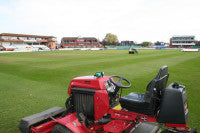
It is a conundrum for Phil. Much of the cricket played at Taunton is the shorter version of the game where, in truth, spectators and pundits expect, and almost demand, a run fest. That's what the shorter versions of the game are about. But Somerset would love to win the County Championship, something they have never done in their long history, and there's the rub.
"I know that commentators and players come here expecting to see runs" says Phil, "and whilst players and ex-players were obviously good at their craft, they are not groundsmen and, to be fair, whilst they can talk the talk, they don't know the job!"
"There was one occasion during the 1999 World Cup when Geoff Boycott, who was advising the Sri Lanka team, came up to me before the game against India and said 'that wicket's damp'. I explained that it was just the colour, but he wouldn't have it. When India lost their first wicket for six runs Boycs searched me out and said 'see, I told you that wicket had moisture in it'. They lost their second wicket at 380, Ganguly making 189 and Dravid 154. I didn't see Boycs again that day!"
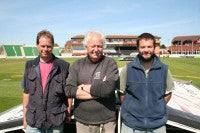
Phil has two full time grounds staff - "I want you to mention them because they are a really good couple of blokes" he says with some pride - Assistant Head Groundsmen, Simon Lee and Dan Stabback. In addition, Phil's younger brother Martin is the maintenance man at the club and helps out when needed.
"I like my lads to have their Saturdays off when possible so, if the workload is not too heavy, my wife will come and help me with covers!"
Whilst Phil could be considered one of the old guard of cricket groundsmen - he can reel off some fascinating names and stories - he has never just 'done the job' and has, from the outset, been prepared to experiment with new ideas and trial new methods.
The square has always been firm, being predominantly the local Mendip soil, plus a dose of marl on some, but, in 1988, Phil was introduced to some new loams by Harry Brind, then the Head Groundsman at The Oval, who was encouraging the use of two of them - Surrey and Ongar.
In 1989 six strips were replaced with Ongar loam. Now I use a mix of Surrey Loams Gostd and Ongar. I'm not saying that this is right for everybody, but it is right for Taunton and works well with the local soil."
A further eight strips have been added to the square in recent years and there are now thirty. Only the eleven central ones are used for first class and ladies games, the remainder for nets and practice.

The ground has no drainage system but relies solely on the free draining nature of the underlying soil. These soils also provide a sub foundation for the square and, without doubt, have been a contributing factor to why Phil has managed to produce some of the best batting wickets in county cricket.
"Taunton has always been a good batting wicket" says Phil. "You've only got to look back through the records. Some of the greats of the game, including The Don, have praised the wicket here."
But the search for something more bowler friendly goes on. It was suggested that koroing off the top one inch might be an answer, so Phil duly obliged, with the assistance of Dave Bates at Total Turf Solutions. "The news got round the press and they all pitched up to see the first game on it, which was against Middlesex" says Phil. "I prepped the pitch as normal and left a bit of grass on. Middlesex went on to declare at 600-4. In reply we made 880 all out. So you see, it's just the nature of the soil that dictates the wickets here."
Phil will prepare a four day wicket for between ten and fourteen days, depending on the level of the match and weather conditions. One day wickets are usually prepped for four to five days. "The wickets are so good here that they don't need any more than that" he says. Phil does not stick to a rigid height of cut and has never measured it - "I just instinctively know what's right"
Winter renovations involved scarifying with a Graden in several directions, with the final pass in the direction of play. Between 8-10 bags of loam were applied to each strip and oversown in three passes. Phil took the opportunity to trial various grass seed mixes across the square. "We've looked at various types and, for our conditions, Evita Majestic is the clear winner. It gives us a tighter sward, stronger root growth, is more resistant to rolling and has less poa in it. It allows me to keep more grass on the wicket, something we like to do here. It might be a bit more expensive than other types but I'm going to use it through the summer and right across the square from here on in."
When Cranfield University were last here they took a core sample and were so impressed with the depth of the roots that they rushed off to their car to get a camera to photograph it!"
Five tracks where renovated using Surrey Loams Gostd with the remainder being dressed with Ongar loam. One track was completely relaid, dug out to a depth of 50mm, refilled with Ongar loam and oversown with Evita/Majestic. The whole square was then fertilised using a 6:5:11 ratio granular fertiliser.
Winter work on the square involves keeping the grass in check, feeding with an 8:0:0 to maintain colour and harden the plant, and aeration when conditions allow. The outfield is also aerated as many times as possible.
Phil, Simon and Dan carried out between 25-30 hours of pre-season rolling starting across the square, then diagonally, before finishing in the line of play. "I'm confident that we have done enough to achieve the right results" he says. "Guidelines are all very well, but they are just that - guidelines. A good groundsman will instinctively know when he has done enough, based on his experience of the square and weather conditions.
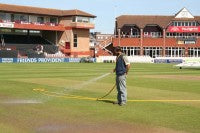
Watering of the wickets is done by hand to control moisture levels. The club has invested in TTS Climate Covers and, more recently, the new Stuart Canvas covers. And this is probably where Phil has his biggest problem. "Seagulls" he curses. "Hundreds of the bloody things. The damage they cause to the covers runs into thousands of pounds."
The population appears to be increasing (Taunton is only twenty-five miles from the coast) and they are opportune scavengers. "We've tried everything - whistles, drums and a permanent scarecrow. We've even resorted to letting off fireworks, which seems to have some affect, but we can't be here all the time, like the bloody gulls are!"
The building of the new stands has transformed the ground. Taunton is one of the smaller grounds on the circuit. Its straight boundaries are still amongst the shortest in first-class cricket. These are sixty yards to the Sir Ian Botham Stand and fifty-three yards to the old pavilion.
Included in the building work is a brand new workshop and mess room for the groundstaff.
Equipment includes a Dennis G860 and Lloyds Paladin for the square, a Toro 2300D Reelmaster used for cutting the outfield, a Graden Scarifier, a SISIS spreader and a pedestrian Groundsman aerator. A trusty old Ford 1210 tractor does all the heavy work and there is the obligatory Blotter for water removal. The rollers are an old Greens Griffin weighing in at three tonnes and a lighter two tonne model.
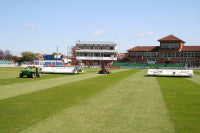
With over thirty years service to the club, Phil still sees every day as a fresh challenge and obviously enjoys the banter with players, spectators and colleagues. "Mind you" he says, "some strange things happen. We allow spectators onto the outfield between innings and, as long as they stay off the square that's not too bad. But, one day, I was rolling the wicket and this drunk bloke wearing a dress leapt onto the roller and nearly knocked me off. It's funny now but, at the time, was pretty dangerous."
With all the edicts, guidelines, last minute swapping of wickets, seagulls, drunk spectators and the increased workload, how does he keep enjoying his job? "In recent years we groundsmen have all been at the mercy of the press, media and, occasionally, umpires who are quick to judge our surfaces at every opportunity" says Phil. "But, there is nothing better than those times when you get praise, and my regular standing in the Cricket Groundsman of the Year must mean I am doing something right."
Phil relates one final story. "At a groundsman's meeting in Durham a few years ago, Pete Eaton, someone I had known and respected greatly, died in his hotel room. Just the night before we had been drinking and sharing stories, and the next day he was gone. It was a great shock and puts what I do, and any problems I might have, into perspective for me."
